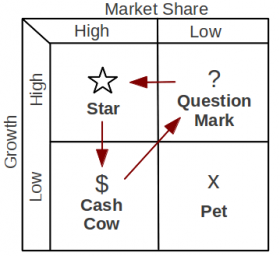Innovation and IP revenue strategies
The non-practicing entity (NPE) model of accruing patents holds a delicate position in the patent sphere. In theory NPEs could help spread innovation, but in practice--particularly in an environment saturated with bad patents--their monetization strategies emerge as somewhat predatory. Still, monetization through aggressive licensing and litigation is an increasingly popular strategy for companies (even practicing ones).
In this article we’re going to examine how technology companies come to rely on strategies of monetization that don’t involve making and selling tangible technology products. When these companies can no longer generate sufficient revenue from making and selling new products on the market, they will commonly resort to pursuing heavy licensing agreements, aggressive infringement litigation, and eventually sale of significant portions of their portfolio. It all comes down to innovation.
The product portfolio
Bruce Henderson, founder of the Boston Consulting Group, described the growth-share matrix. It appears in “the Product Portfolio,” a 1980 article included in the group’s book “On Strategy,” and has since become a ubiquitous image for the analysis of business performance. The four quadrants of the matrix represent different possible stages in the lifetime of a product.
 Low-growth-and-high-market-share products make more money than the company need put back into that product. These “cash cows” are nice, but alone cannot support sustained growth and profitability for a company. High-growth-and-high-market-share products, or “stars,” are profitable but do not necessarily pay for themselves. Some of these products, with investment, turn into cash cows that help sustain a company. High-growth-and-low-market-share products are “question marks.” These products, often still in development could continue to grow, gain market share, and become stars. They could also see a decline in growth. In this case, a product becomes the low-growth-and-low-market-share “pet” products that generally barely break even, and likely offer no significant revenue for the company.
Low-growth-and-high-market-share products make more money than the company need put back into that product. These “cash cows” are nice, but alone cannot support sustained growth and profitability for a company. High-growth-and-high-market-share products, or “stars,” are profitable but do not necessarily pay for themselves. Some of these products, with investment, turn into cash cows that help sustain a company. High-growth-and-low-market-share products are “question marks.” These products, often still in development could continue to grow, gain market share, and become stars. They could also see a decline in growth. In this case, a product becomes the low-growth-and-low-market-share “pet” products that generally barely break even, and likely offer no significant revenue for the company.
“All products become either cash cows or pets.”
Henderson uses this principle for the basis for what he calls the “success sequence.” Inevitably, a product’s growth with slow and it will settle into one of the two low-growth quadrants. Henderson’s argument for maintaining a portfolio of products follows from this assumption. “Every company needs products in which to invest cash. Every company needs products that generate cash. And every product should eventually be a cash generator; otherwise it is worthless.” For a company to become successful, it must be investing money in question-marks--ensuring that there will be enough stars, and eventually cash cows, to sustain the company. A central point is consistent reinvestment in question marks.

For technology companies staying on-top of this cycle is critical because the market moves fast, highly dependent on fickle consumer tastes and often rapid obsolescence of products with new developments. This means investing heavily in generating more question marks or, in other words, investing heavily in innovation.
A cash cow one year could become a pet product the next, and if there is no new product to move into its place and keep up the company’s revenue, that company will look to other ways to monetize its assets. For tech companies, this alternative means getting creative with their bloated patent portfolios. This is certainly legitimate strategies to bolster a company’s revenue, as we discussed at the beginning of this article. Seldom does this strategy make for a successful tech company.
Internalizing innovation
Nokia is certainly still a practicing company--they produce new devices and sell them (at least some) to consumers. Nokia has, though, lagged significantly behind in their ability to innovate and generate new products. With not enough investment in “big” question marks before their “big” cash cows lost their significant market share, Nokia has turned in desperation to alternative revenue streams. Now, the majority of their revenue comes from licensing. A company like Apple draws a sharp and informative contrast. Innovation runs in Apple’s bloodstream, and has consistently been a central focus. Though Apple does pursue licensing and litigation (par for the course for a large tech company), this is largely to protect the market share of their star products and cash cows. Their success is a shining example of a technology company’s version of Henderson’s success cycle, and a testament to the benefits of investing heavily in innovation (and therefore “question marks.)